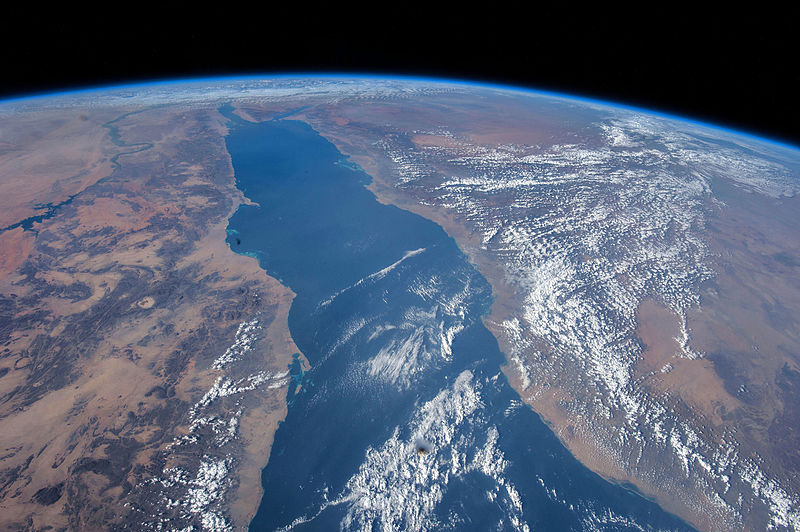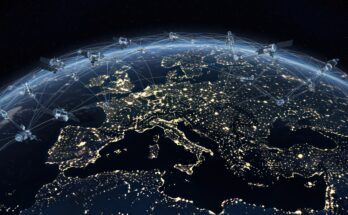by Nicholas Rakoncza and Carter Palmer

Various news outlets have recently reported that four of 15 underwater internet cables have been severed in the Red Sea. According to SpaceNews and HGC Global Communications, 25% of internet traffic has been affected in the region.
With capacity in the Red Sea region diminished by 25%, customers are already looking to Space to fulfill their needs. According to SpaceNews, Intelsat has already been tapped by customers looking to regain their previous capability. With so many space-based purveyors of internet, SES, Intelsat, Eutelsat OneWeb and SpaceX as examples, the severing of cables demonstrates both terrestrial and satellite have their drawbacks and their advantages.
Submarine cables have played an important role in both military and civilian communication. Thanks to multiple technological advances, the first successful submarine telegraph cable in wartime was during the Crimean War when telegraph cable was laid from Varna to Balaclava along the Crimean Coast. Telegraph communication, and the innovative strategy of laying cable underwater, changed command, control, and intelligence (C2I) and paved the way for other models of command and control that exist today. While multiband radio and satellites have replaced some of our needs for submarine cables, 95 percent of data and voice transfers are still reliant on this cable infrastructure.
Like the military, civilians rely on submarine cables that continue to play a vital part in our global economy as billions of people and thousands of institutions use terrestrial telecommunication systems in their daily lives and operations. In a 2022 survey, the Bank for International Settlements stated currency trading reached an average of $7.5 trillion per day in April 2022. The global e-commerce market is valued at approximately $6.3 trillion in 2023 with an estimated forecast of 21.2 percent of total retail sales occurring online in 2024. Outside of finance and commerce, the increased recognition of the internet as a human right is inserting the internet into a foundational role for freedom and democracy. None of this would be possible without submarine cables and we must recognize that a large-scale disruption of these cables would lead to multiple immediate global financial and political crises.
With the adoption of new technologies come strategies to disrupt said technologies. During the Spanish-American War, the United States Navy cut a submarine cable that connected Cuba and Madrid. During the First World War, the British developed strategies to disrupt German submarine cables that were so successful that only one cable remained at the end of the war. During the Second World War, submarine cable cutting was also prevalent. During the Cold War, one of the more notable instances of submarine cable disruption was when the Novorossilsk, a Soviet trawler, caused significant damage to transatlantic cables off the coast of Newfoundland. After the Novorossilsk incident, both the United States and the Soviet Union reiterated the importance of an international effort to protect submarine cables.
Damage to submarine cables continues during the 21st Century. Damage to the Svalbardfiberen, two submarine cables owned and operated by Space Norway AS, in January 2022 disrupted data traffic between Svalbard and Harstad. The cause of the damage to Svalbardfiberen is still unknown, but the incident ignited a flurry of accusations against Russia which, to this day, have yet to be proven.
The recent disruptions to submarine cables in the Red Sea (for which Houthis deny responsibility), such as the Asia-Africa-Europe 1, the Europe India Gateway, Seacom and TGN-Gulf, have impacted 25 percent of data traffic flowing from Asia to Europe. While this data has been rerouted, it raises the question of whether our current infrastructure can support such adjustments on a regular basis.
As threats to our telecommunications infrastructure increase, the need for the international community to safeguard our global communications infrastructure should be prioritized. A legal framework to protect these cables exists at a national and multilateral level. At the national level, in the United States, the Communications Security, Reliability, and Interoperability Council provides recommendations to the Federal Communications Commission with way to protect our communications. Multilateral efforts, such as the Convention for the Protection of Submarine Telegraph Cables (1884), requires that all signatories protect international submarine cables. International treaties, such as the United Nations Conference on the Law of the Sea, reinforces the 1884 treaty. Additionally, articles 113 through 115 of the United Nations Convention on the Law of the Sea address the responsibility of the international community to prevent the breaking or injury of subsea cables. Organizations such as the International Cable Protection Committee provide guidelines and recommendations to submarine cables.
Satellite communication is increasingly important as threats to undersea cables and the critical infrastructure required for their operation increase. Depending on the type of cable, repairs to submarine cables can take anywhere from days to over a year to repair, as was the case in Tonga. The vast majority of submarine cable disruptions are caused by fishing and anchoring activities while other instances are caused by natural hazards. Deliberate disruptions to our submarine cables are rare but could increase as nefarious actors continue to challenge the global order. Currently, satellites cannot replace submarine cables because they could not handle the massive data flows that a submarine cable can. The best we can do is continue research and development, leading to the eventual deployment, of a satellite network that can replace submarine cables in the future. For now, it is the responsibility of the international community to protect submarine cables against disruptions.
Satellites are vulnerable in their own right however. Recent news about Russia possibly placing nuclear weapons in orbit illustrates that satellites could be destroyed or disabled in orbit. With this situation quite opposite, terrestrial networks would indeed be needed to take up the slack. ViaSat at the beginning of the Russian invasion of Ukraine suffered a cyber-attack, likely by Russian hackers, which disabled wind turbines in Germany. Although this attack disabled modems rather than satellites themselves, vulnerability of Space assets was highlighted.
This is not the first time satellites have been called into action because of compromised terrestrial networks. As SpaceNews illustrates, the 2022 volcanic eruption in Tonga damaged subsea cables. Intelsat and SES were called in and restored service. Ukraine has been using SpaceX’s Starlink for communications since the beginning of the war.
Moving forward it appears that both Space-based and terrestrial communication systems will become targets for various actors. Although severing a cable might be easier than disabling a satellite for certain aggressors, it might be wise for those on the receiving end to be aware of their weaknesses regarding communications; both civil and military. The international community must hold nefarious actors accountable for deliberate disruptions because, if we do not, the world will suffer due to its reliance on global telecommunications.



